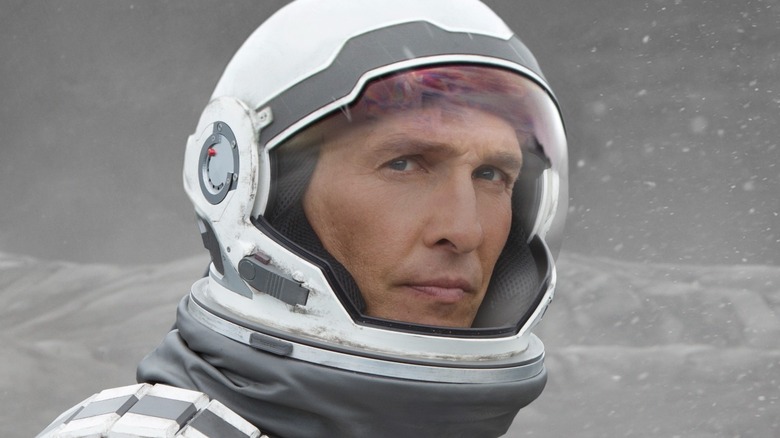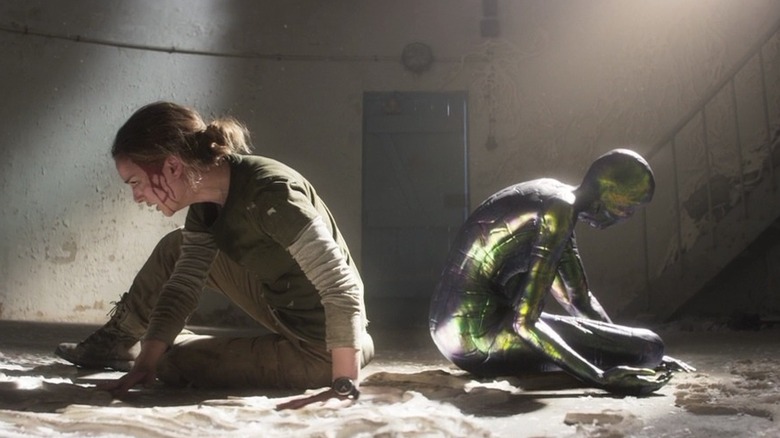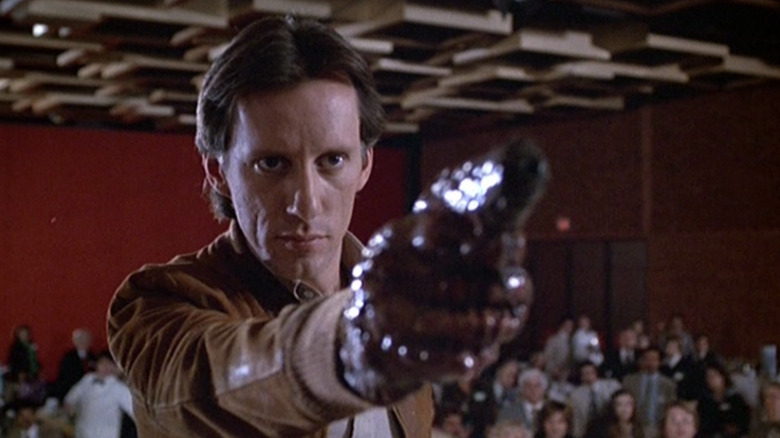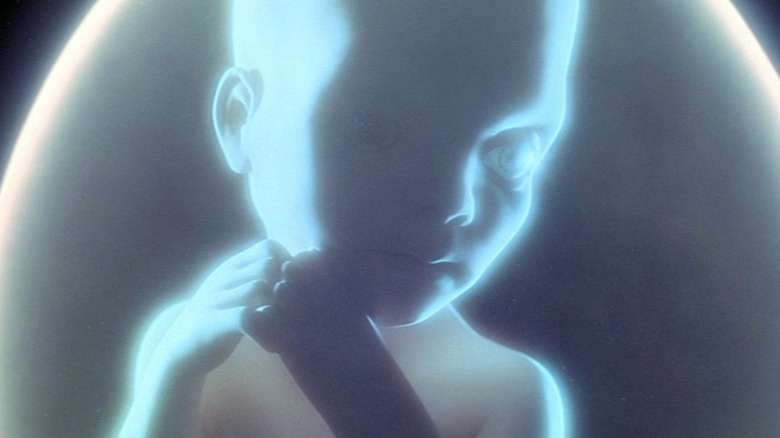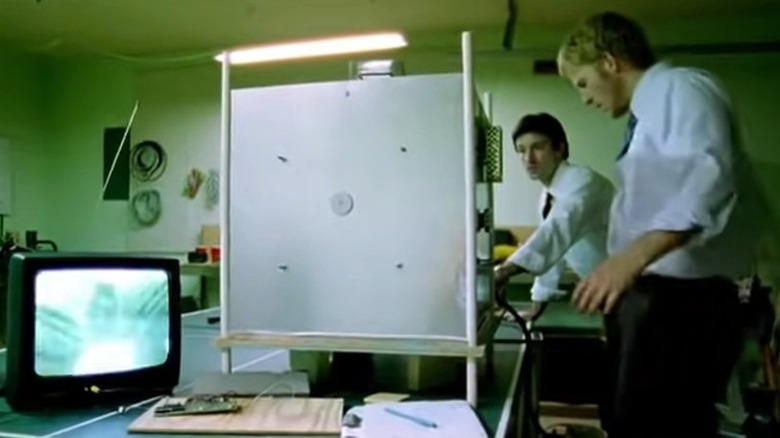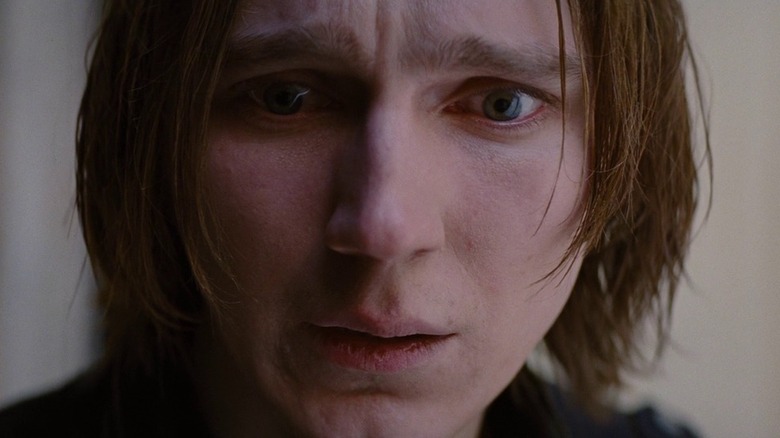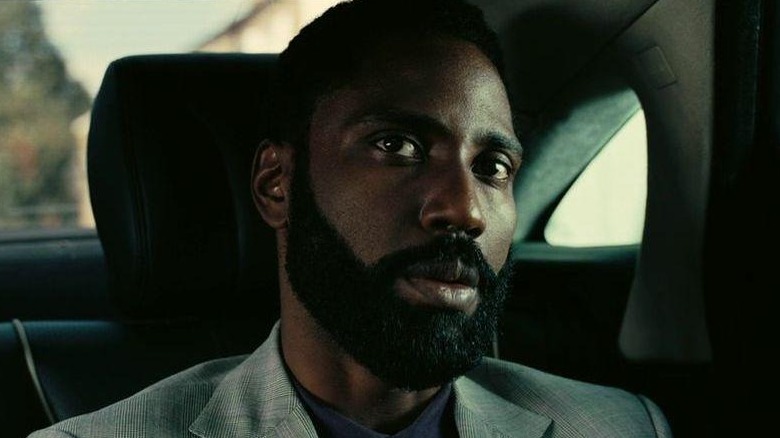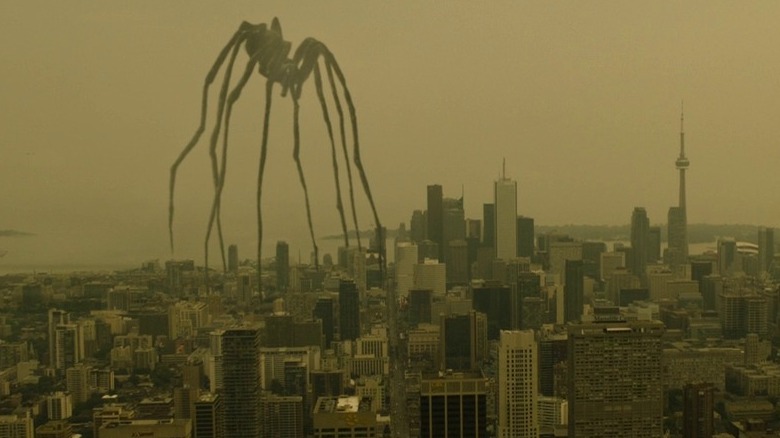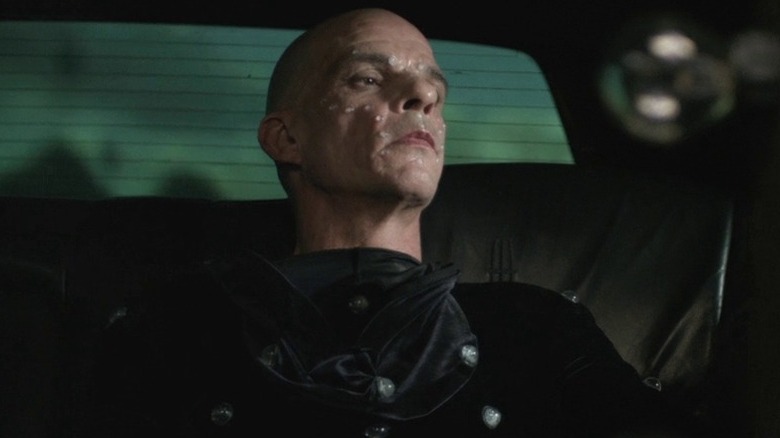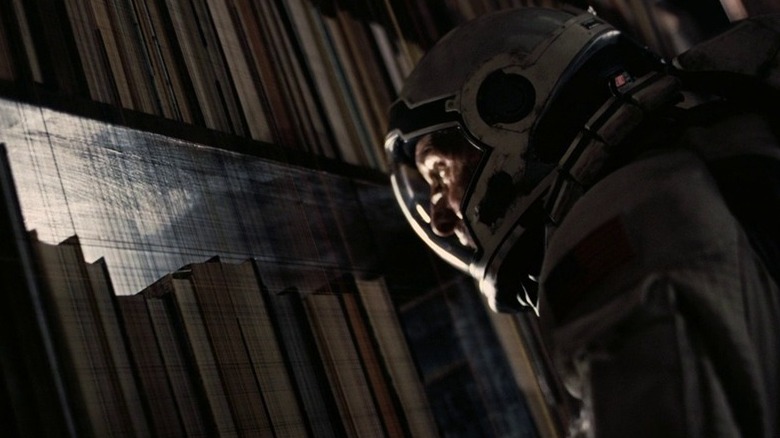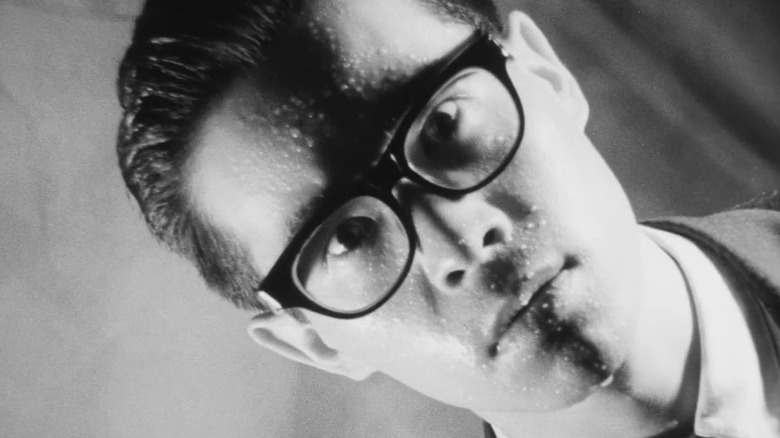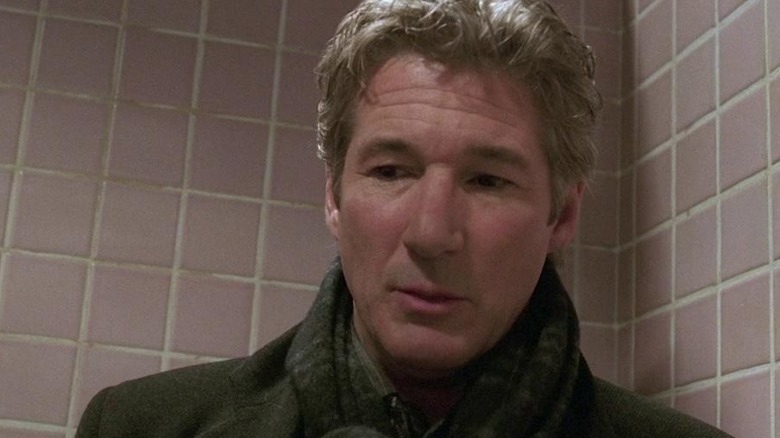The Most Confusing Moments In Sci-Fi Movie History Explained
Due to the futuristic settings, high-tech gadgetry, and heady themes often associated with the genre, sci-fi movies can provide viewers with plenty of confusing moments. Some take a grounded and realistic approach to the blending of science and fiction, while others play fast and loose with the rules of reality. A few are completely divorced from our own perception of the natural world, existing in their own exaggerated realities instead.
Confusing moments in the sci-fi genre can fall into one of two categories: confusing in a good way, and confusing in a bad way. The good type of confusion is typically intentional on the part of the filmmaker. The goal of many sci-fi films is to instill a sense of awe and blow the minds of viewers, and a healthy dose of strangeness can be a boon in that regard. Bad confusion, on the other hand, arises unintentionally. Mystifying the viewer can be an accidental consequence of messy storytelling, poorly explained or implemented sci-fi tech, a general lack of clarity, inconsistencies in the rules of the world, or even outright plot holes. Here, we've assembled a collection of both kinds to find and explain the most confusing moments in sci-fi movie history.
The mirror — Annihilation
"Annihilation" is a sci-fi adventure film with a healthy dose of horror. The story concerns a large patch of American wilderness that's been overtaken by an otherworldly field dubbed "the shimmer." Within the contamination zone, all manner of organic life has been mutated. This leads to plenty of moments and visuals designed to mess with the viewer's mind.
At the climax of the film, Lena (Natalie Portman) finally reaches the lighthouse deep within the shimmer that was her squad's objective. What ensues is easily the most confusing (in a good way) portion of the film. In the center of an underground alien lair beneath the lighthouse, she sees an impossible sight: a nebulous sphere of self-creating and self-destroying otherworldly energy. Before you can wrap your head around what you're seeing, an alien figure emerges and takes Lena's own physical form. This entire climactic sequence is designed to keep the viewer in a constant state of bafflement, but while the actions and intentions of the alien aren't immediately apparent, they can be interpreted.
The blank figure mirrors Lena's movements yet retains the free will to outmaneuver and overpower her. The alien aims to become her, using the shimmer to replicate her cell by cell. By studying and mimicking her movements, the double not only takes on Lena's visual appearance but also matches her physicality and personal way of moving, becoming a more authentic duplicate. The whole sequence is also a gorgeous visualization of the film's running theme of self-destruction. Though Lena appears to escape, the film concludes on an unsettlingly ambiguous note, leaving the possibility that the alien was actually successful in taking her place.
The flesh gun — Videodrome
The body horror stylings of director David Cronenberg have produced plenty of confusing and disgusting moments on screen. "Videodrome" is one of Cronenberg's finest films and also one of his most grotesque. In it, TV producer Max Renn (James Woods) undergoes a series of horrific bodily transformations, such as forming a fleshy slit in his stomach that ingests a Betamax tape.
There are plenty of outrageous and baffling moments in the film, but one of the most confusing involves the flesh gun. After having the tape forced into his stomach, Max flees, then reaches inside himself to pull it out. Instead of the tape, he removes a goop-covered Walther PPK handgun. As if that weren't strange enough, the gun then fuses with his hand via metal spikes that burrow through his wrist, becoming a permanent part of his anatomy. Further adding to the confusion is the fact that the projectiles fired from the gun don't have the effect of normal bullets. Instead, they cause the victim's body to transform, bulge, and burst apart.
On the surface level, all of this could come off as nightmarish and purely nonsensical, but it does follow the internal logic of the film and support its themes. Renn is becoming the human manifestation of "the video word made flesh," as is said in the film. As explained by Cronenberg and described in the original script, the projectiles fired by the gun aren't bullets, but cancer, causing tumorous eruptions in the victim (via Criterion).
The Star Child — 2001: A Space Odyssey
Told with Stanley Kubrick's trademark directorial style, "2001: A Space Odyssey" can be straightforward and easy to follow one moment, then nebulous and esoteric the next. Moments of confusion arise from the very beginning of the film with the first appearance of the alien monoliths. Things get even more confusing towards the end of the film after the trippy stargate sequence, in which Bowman (Keir Dullea) finds himself trapped in bed in a strange room where time loses all meaning. To cap it all off, the film ends with the famous Star Child scene in which a massive celestial baby hovers over Earth. Kubrick avoids explanations on the screen, instead leaving things up to viewer interpretation.
There are some answers to be found in the novel, written in tandem with the film by Kubrick's collaborator Arthur C. Clarke, but they don't fully line up (via CineFix). Debates over the meaning of the Star Child, the monolith, and other visuals and symbols have flourished throughout print and online discourse since the film's release decades ago, but there might actually be a concrete answer out there. In 1980, Japanese documentarian Jun'ichi Yaoi conducted a phone interview with Kubrick, which is thought to be the only recorded instance of Kubrick explaining the meaning of the ending of "2001: A Space Odyssey" (via image circulation on YouTube). Kubrick confirmed that Bowman is placed in a sort of "human zoo" by "god-like entities" so that they can study him. His sense of time is distorted, and his entire life plays out in that strange captivity. Bowman is then transformed into the Star Child and returned to Earth as "some sort of superman."
Time travel — Primer
"Primer" is a remarkable little sci-fi indie film, made on an almost unfathomably low budget of just $7,000. Despite these financial limitations, the story of "Primer" is incredibly ambitious.
Time travel movies often feature complex plots, but "Primer" just might have the most complicated of them all. On a single viewing, audience members are practically guaranteed to be confused by the film's timeline. In an interview with Reverse Shot, star, writer, and director (among other roles) Shane Carruth acknowledged how dense and potentially baffling the film is, but said, "The information's all there. It's not ungettable. It might require a second or third viewing, but that's what I was going for." While many movies involving time travel bend the rules, establish their own time-travel logic, or ignore major plot holes, "Primer" takes the most realistic approach possible. It's a film that demands rewatches and high-level analysis to fully understand everything that's going on.
In essence, the time travel works like a series of self-interrupting loops. The machine is activated at the point in time the user wishes to return to later. They then wait out the corresponding amount of time before actually entering it. This process creates a new timeline and effectively replaces the old one — sort of. To fully understand all of the ins and outs of the "Primer" timeline, a lot more research and analysis is required, but it is possible.
The Tree — The Fountain
"The Fountain" uses both sci-fi and fantasy elements to tell a layered narrative taking place in different time periods. Hugh Jackman and Rachel Weisz play different but connected characters across three main timelines, and the plot essentially boils down to an epic love story between them split through the 1500s, the 2000s, and centuries into the distant future. The modern-day storyline is the most straightforward and finds Jackman as a doctor trying and failing to save his wife (Weisz), who is dying of cancer. The confusion doesn't arise until the far-future segment.
Jackman's future character travels through a golden celestial plane in a spherical biome, transporting himself and a tree through space to a place called Xibalba (the name of the Mayan Underworld). The tree that dominates the biome is a loaded symbol that has caused plenty of confusion and debate amongst viewers, but it actually has a pretty simple answer.
The tree is a factor in all three time periods. In the 1500s timeline, Jackman's conquistador character is searching for the Tree of Life, which he finds and is destroyed by. In the contemporary timeline, Jackman uses an extract from the tree to try to treat his wife's cancer. In the future timeline, Weisz's character has essentially become the tree and now provides the sustenance that keeps Jackman's character alive at the cost of its own vitality. The contemporary plot is the most literal of the three, while the other two can be interpreted as either literal or figurative. It's even possible that the other two timelines could be chapters in the book being written by Weisz's present-day character. The futuristic finale could then be the final chapter written by Jackman's present-day incarnation after his wife has passed away. In a 2012 interview with IndieWire, director Darren Aronofsky said, "ultimately the film is about coming to terms with your own death" (via Grantland).
Instant Scarring — Looper
Before jumping into the "Star Wars" universe with "The Last Jedi" and starting his own film franchise with "Knives Out," director Rian Johnson made the standalone sci-fi film "Looper"
in 2012. "Looper" takes place in both the near and distant future. In the further timeline, getting away with murder is so difficult that the mob opts to send their victims back in time to have them killed in the past. It's a unique premise for a time-travel movie, but it brings a few confusing moments along with it.
As is the case with many time travel films, the plot of "Looper" can start to fall apart a little bit the more you think about it. The instant scarification and mutilation of Seth (Paul Dano and Frank Brennan) in particular raise a lot of questions that go unanswered. As the character's body is mutilated in the earlier timeline, those injuries appear in real-time on his distant-future self, and he notices them there for the first time. But does this add up? Surely he would have had those injuries for decades by that point since they were inflicted in the past, right? "Looper" asks the viewer to suspend their disbelief and not think too hard about the internal time-travel logic of the film. The answer to this confusing moment might just be that it's a bit of a plot hole, but since time travel is all theoretical, it could also just be the way it happens to work in this universe.
Human harvesting — Under the Skin
"Under the Skin" is a brilliant example of a filmmaker intentionally causing confusion in the viewer in order to unnerve and strike awe into them. Scarlett Johansson plays an unnamed alien who hunts various humans in strange and mystifying ways. The solid black room where she lures men and sinks them into the floor, the shaft of gore tumbling toward a red rectangle in the middle of a void, and the way the victims burst like balloons are all confusing and impenetrable elements at face value. Understanding the truth of what's happening in the film requires some additional analysis, but the clues are all there.
The alien's purpose on earth is to harvest the biological material of humans. As director Jonathan Glazer explained in an interview with Film4, the white and black rooms represent alien interiors that our human minds can't properly comprehend. Everything that happens within the black room represents the harvesting process, whereby the men lured in are mined for their biological materials and left as empty husks of skin. Though the film is far from a faithful adaptation of the source novel written by Michel Faber, there are still answers to be found in the original text. The book lacks the ambiguity of the film and spells out the aliens' intentions and harvesting processes in more explicit detail.
The Protagonist — Tenet
Christopher Nolan's "Tenet" has been one of the most divisive directorial efforts of his career. Much of the film is dense and confusing to a fault. It remains open for debate whether "Tenet" is a genius, high-level work that many people simply don't understand, or if it's just a pseudo-intellectual mess that obfuscates information for the sake of seeming smarter than it really is.
The heady time-travel and time-inversion plot devices paired with the impenetrable storytelling style lead to a general sense of bafflement throughout much of the film. And the twist at the end of the film that reveals John David Washington's "Protagonist" character's true identity might be the most confusing of all. It's revealed that the mission we watch him pursue is in fact a goal that he set for himself in the future. Extensive explanations and timeline breakdowns have been written since the film was released, which explain the various time inversion loops in great detail. In essence, the twist relies on a sort of causality loop, encouraging repeat viewings to catch how everything shakes out. Whether or not the plotting is too convoluted is ultimately up to each individual viewer, but as is always the case with Nolan's sci-fi films, there is an internal logic.
The spiders — Enemy
Throughout Denis Villeneuve's psychological thriller "Enemy," spiders are a key symbol. The ambiguous story finds Jake Gyllenhaal playing two roles in what is essentially a doppelgänger film. One character is a teacher, the other is an actor, and when they learn of each other's existence, everything they think they know is called into question. The presence of the spiders is literal at some points and figurative at others. The film never explains the significance of the spiders, and they can be interpreted in multiple ways.
When asked about the spiders in interviews, Villeneuve has often dodged the question. In a 2014 interview with Curzon, he said, seemingly in jest, "I cannot talk about the spiders because I need more therapy." As covered by Vulture, Villeneuve once hinted at the meaning of the spiders in an interview featured on Amazon. He said that the spider symbol was, "An image that I found that was a pretty hypnotic and profound [way] to express something about femininity." He went on to describe the spider imagery in the film as "images that are frightening and oppressive, but at the same time, you feel the image. It prints itself in your brain, but you feel uncomfortable with it."
Given that "Enemy" was adapted from a novel — "The Double" by Portuguese author José Saramago — you might expect to find more concrete answers in the source material. However, the spiders are a unique addition made by Villeneuve for the film. In the same Amazon interview, Villeneuve said of the spider imagery, "It's not in the novel, and I'm not sure if Saramago would've been happy with the idea."
Talking cars — Holy Motors
"Holy Motors" is a French surrealist and absurdist comedy and drama from acclaimed French filmmaker Leos Carax. In the film, Mr. Oscar (Denis Lavant) works a job that finds him shepherded through Paris via limousine to different dream-like appointments in what essentially amounts to a vignette film. Each appointment has him adopting different characters and acting out roles as if in a work of fiction, though he interacts with the unsuspecting public, and there is no outward artifice for his performances.
In a film full of intentionally bizarre and nonsensical moments, it says a lot that the most confusing moment arrives at the climax of the film. At the end of the night, the limousine is returned to its garage at the titular Holy Motors company. This is when it's revealed that the limousine, along with the dozens of other limousines in the garage, is actually a sentient being. They then converse about their respective days.
All of the impossibilities on screen are presented plainly, allowing any and all interpretations to be projected onto them. One way to read the film is to extrapolate the notion of "art imitates life" to the logical extreme of "art is life." Another interpretation posited by independent film critic Taylor Holmes is that Carax was trying to invert and play with the idea of "cinema verité" — a French filmmaking approach that values extreme naturalism. In a film as off-the-wall absurd as this, searching for a sole logical explanation will always result in a dead end. Things that just don't make any sense are all part of the ride.
The bookshelf — Interstellar
"Interstellar" is full of complex science of both the practical and theoretical varieties. Most of these ideas are clearly communicated and easy for the average viewer to digest, but one moment toward the end is especially confusing – when Cooper (Matthew McConaughey) winds up inside of a bookcase back in time in his daughter's childhood bedroom and passes her a message. For as strange as it seems at face value, all of the science and math in the film supposedly checks out, at least according to the original source.
Nobel Prize-winning astrophysicist Kip Thorne played a major role in the film's production as an executive producer, consulting on all of the sciency matters. Thorne even wrote a whole book entitled "The Science of Interstellar" that breaks the film down in minute detail. The simplified explanation for the bookcase sequence is that Cooper is actually inside of a tesseract – a four-dimensional cube. What Cooper sees is a dumbed-down visual representation of a five-dimensional reality beyond his and our comprehension, which was created by the minds of a more sophisticated species. Essentially, Cooper is moving through time as if it were a physical place. It's also suggested that the advanced species in question might actually be humans from the far future.
Thorne certainly has bona fide credentials, but some other established scientists have disagreed with aspects of the film. It seems there may still be plenty of fiction in this science fiction film.
Transformations — Tetsuo: The Iron Man
"Tetsuo: The Iron Man" is an incredibly bizarre Japanese sci-fi horror movie from 1989. The film operates by its own internal logic in a strange version of our world, and the story that unfolds on screen in stark black and white is basically non-stop confusion from start to finish. Pursued by a mysterious villain, the main character's body is increasingly afflicted with all manner of grotesque metallic and mechanical augmentations, and he struggles to distinguish dreams from reality.
While the film may seem nonsensical when judged by the laws of our own reality, it has a rhyme and reason all its own. Director Shinya Tsukamoto's unique vision is unlike anything else, and following the story requires the viewer to get on board with his personal brand of twisted surrealism and experimental filmmaking. The two keys to understanding the narrative of the film are to accept the fact that in "Tetsuo: The Iron Man," metal and sexuality are intrinsically linked – as explored in Visual Cult Magazine — and that the concept of transhumanism is at the heart of the film's exploration of body horror (per Little White Lies).
The man at the start of the film is a metal fetishist (as he is listed in the credits), and yes, that is exactly what it sounds like. By violently encountering this character early in the film, the protagonist can be viewed as contracting a kind of metallic STI from him, which spreads throughout his body and others in the form of horrific mechanical transformations.
Losing time — The Mothman Prophecies
"The Mothman Prophecies" is a 2002 psychological thriller with flashes of sci-fi, fantasy, and horror. The film attempts to bring the real-life urban legend of the West Virginia Mothman to the big screen, including the infamous incident where the Mothman supposedly foreshadowed the collapse of a bridge that claimed the lives of 46 people. There is a lot within the plot of "The Mothman Prophecies" that doesn't make sense at face value, and it's all done intentionally. The film's most confusing moment sticks out as unnerving in a positive way because it's acknowledged as being physically impossible.
While supposedly on his way to southern Virginia, lead protagonist John Klein (Richard Gere) somehow travels hundreds of miles away from where he was headed to West Virginia in the middle of the night. To make matters stranger, when he knocks on the door of a nearby home and asks to use the phone, the man inside says that John has knocked on his door at the exact same time the past two nights. One could try to explain these strange happenings as the result of some kind of mental illness suffered by the main character, or you could justify them as supernatural occurrences caused by the supposed Mothman, but there is no explicit answer. The whole point is that these actions are unexplainable, just as many urban legends often are.
